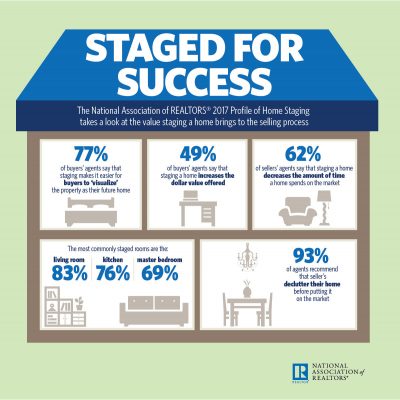Home Staging Decreases Time on Market
Sixty-two percent of sellers’ agents say that staging a home decreases the amount of time a home spends on the market, according to the National Association of Realtors® 2017 Profile of Home Staging, www.nar.realtor/reports/profile-of-home-staging.
“Realtors® know how important it is for buyers to be able to picture themselves living in a home and, according to NAR’s most recent report, staging a home makes that process much easier for potential buyers,” said NAR President William E. Brown, a Realtor® from Alamo, California and founder of Investment Properties. “While all real estate is local, and many factors play into what a home is worth and how much buyers are will to pay for it, staging can be the extra step sellers take to help sell their home more quickly and for a higher dollar value.”
According to the report, which is in its second iteration, nearly two-thirds of sellers’ agents said that staging a home decreases the amount of time the home spends on the market, with 39 percent saying that it greatly decreases the time and 23 percent saying it slightly decreases the time. Sixteen percent of sellers’ agents believe that staging either greatly or slightly increases a home’s time on the market, while 8 percent believe that it has no impact.

2017 Home Staging Report (PRNewsfoto/National Association of Realtors)
Seventy-seven percent of buyers’ agents said that staging a home makes it easier for buyers to visualize the property as their future home, and 40 percent are more willing to walk through a staged home they first saw online. However, 38 percent of buyers’ agents said that staging positively affects a home’s value if the home is decorated to the buyer’s taste, meaning that a home’s staging should be designed to appeal to the largest number of potential buyers.
Forty-nine percent of buyers’ agents said that staging has an effect on most buyers. Another 48 percent stated that staging has an effect on some buyers’ opinion of a home, but not always, and only 4 percent said that it has no impact on buyers.
Realtors® representing both buyers and sellers agreed that the living room is the most important room in a home to stage, followed by the master bedroom, the kitchen, and then the yard or outdoor space. The guest bedroom is considered the least important room to stage.
The highest share of buyers’ agents, 31 percent, reported that staging a home increases its dollar value by 1 to 5 percent. Thirteen percent said that staging increases the dollar value 6 to 10 percent, while 25 percent stated it has no impact on dollar value. Only 1 percent of buyers’ agents felt that staging has a negative impact on a home’s dollar value.
Sellers’ agents report even more value is added from staging: 29 percent reported an increase of one to five percent in dollar value offered by buyers, 21 percent reporting an increase of 8 to 10 percent, and 5 percent reported an increase of 11 to 15 percent. No sellers’ agents reported a negative impact.
When deciding which homes to stage, 38 percent of sellers’ agents said that they stage all of their sellers’ homes before listing them, 14 percent will stage only homes that are difficult to sell, and 7 percent stage only homes in higher price brackets. Thirty-seven percent of sellers’ agents said they do not stage homes before listing them, but they recommend sellers declutter their homes and fix any faults with the property.
When it comes to paying for home staging, 25 percent of the time the seller pays before listing the home. Twenty-one percent of sellers’ agents will personally provide funds to stage the home, while 14 percent of agents will offer home staging services to sellers.
Beyond staging, agents also named the most common home improvement projects they recommend to sellers: Ninety-three percent recommend decluttering the home, 89 percent recommend an entire home cleaning, and 81 percent recommend carpet cleaning. Other pre-sale projects include depersonalizing the home, removing pets during showings and making minor repairs.
In March 2017, NAR invited a random sample of 53,760 active Realtor® members to fill out an online survey. A total of 1,894 useable responses were received for an overall response rate of 3.5 percent. At the 95 percent confidence level the margin of error is plus-or-minus 2.25 percent.






